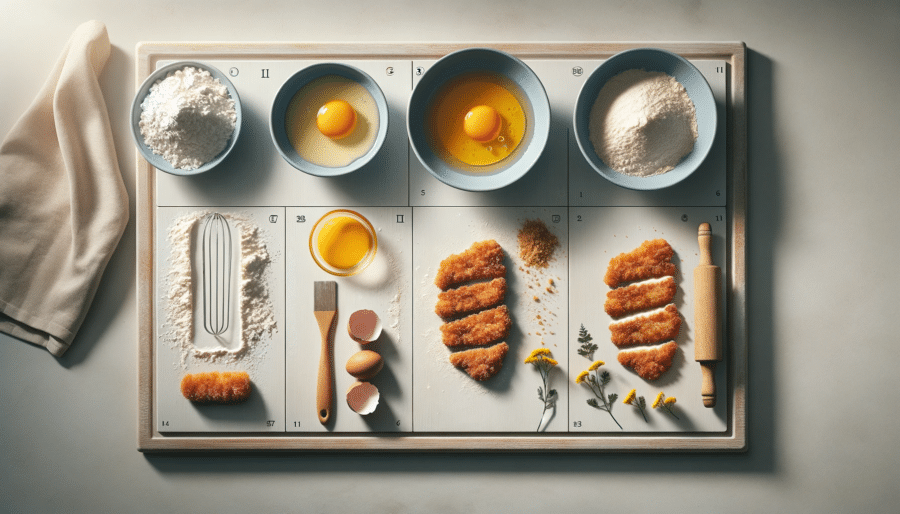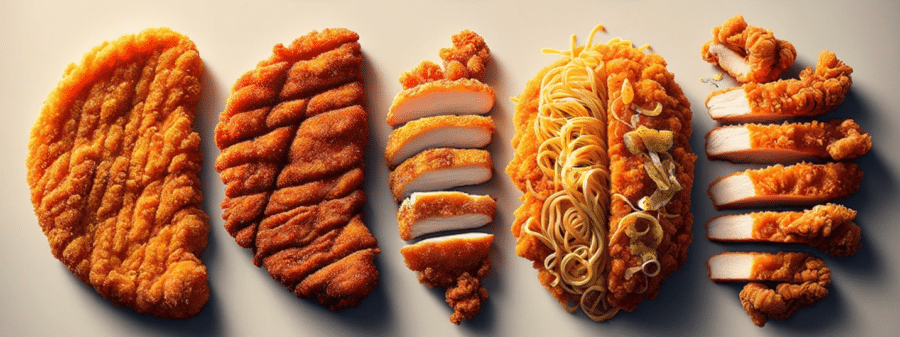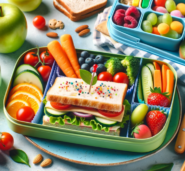- Reading time: About 8-10 minutes.
- Overview: A comprehensive guide to perfect breaded schnitzels, a classic European cuisine with worldwide popularity.
- Meat Selection: Detailed explanation of choosing the best meat, including traditional veal for Wiener Schnitzel and modern alternatives like pork, chicken and turkey.
- Spices and marinades: The importance of spices and marinades for flavor, including classic and innovative recipes.
- Breading and frying techniques: Practical instructions for breading and frying, with tips for avoiding common mistakes.
- Side dishes and recipe ideas: Suggestions for suitable side dishes and creative ways to integrate schnitzel into dishes.
- Cultural Variations and Dietary Options: Insights into different cultural preparation methods and tips for gluten-free and vegetarian versions.
- FAQ: Answers to frequently asked questions to improve your schnitzel cooking experience.
Choosing the best meat

Why meat selection is crucial
Choosing the right meat is crucial for the quality of a perfectly breaded schnitzel. Each type of meat brings its own unique characteristics in terms of taste and texture, which significantly influences the end result.
Traditional veal for Wiener Schnitzel
- taste and texture: Veal is known for its tender, fine-grained meat. It has a subtle, almost buttery flavor that's great for a classic Wiener Schnitzel.
- Preparation: Since veal is naturally tender, it requires a shorter cooking time. This helps preserve its tenderness and juiciness.
- cultural significance: In Austria, the birthplace of Wiener Schnitzel, veal is considered the authentic choice.
Modern alternatives: pork, chicken, turkey
- Pork: Offers a juicier and often spicier option. It is thicker and firmer than veal, giving it a distinct texture.
- chicken: A lighter, lower fat alternative. Chicken breast is particularly suitable for a more tender, healthier schnitzel.
- Turkey: Similar to chicken, but with a slightly stronger flavor. Turkey schnitzels are ideal for those who prefer a leaner but more flavorful option.
Veal – A classic for Viennese schnitzel

Veal is ideal for the traditional Wiener Schnitzel. Here are some reasons why veal works so well in this classic dish:
- Tender meat: Veal comes from young cattle and is therefore particularly soft and tender. This tenderness makes the meat perfect for schnitzel as it remains tender and juicy after frying.
- Mild taste: Veal has a subtle, almost butter-like flavor. This mild flavor goes well with the crispy breading of the schnitzel without being too dominant. This brings out the natural meat flavor.
- Tradition: In Austria, where Wiener Schnitzel comes from, veal is the traditional choice. The use of veal for Wiener Schnitzel is an important part of Austrian food culture.
- Health benefits: Veal is healthy because it contains a lot of protein, vitamins and minerals, but less fat than many other meats. This makes it a healthier option for schnitzel.
- Easy to prepare: Veal does not need to be cooked for long because it is so tender. A short frying time is ideal to keep the meat juicy and the breading crispy.
Pork, chicken, turkey – modern alternatives
Pork, chicken and turkey are popular modern alternatives to veal for breaded schnitzels. Each of these meats has its own characteristics that make them suitable for different tastes and preferences.
- Pork: Pork is a common choice for schnitzel. It is usually juicier and has a stronger flavor than veal. The meat is slightly thicker and firmer, giving it a good texture. Pork schnitzel is ideal for those who prefer a heartier, more flavorful schnitzel.
- chicken: Chicken is a lighter, lower-fat option for schnitzel. It is particularly popular with people who are looking for a healthier diet. Chicken breast is tender and absorbs spices and marinades well, making it a versatile choice for schnitzels. Chicken schnitzels are often the choice for a lighter, but still tasty meal.
- Turkey: Turkey is another low-fat option and is similar to chicken in many ways, but offers a slightly more intense flavor. Turkey schnitzel is ideal for those looking for a leaner alternative to traditional schnitzel but want a little more flavor than chicken.
Spices and marinades

The key to perfect taste
Spices and marinades play a crucial role in preparing perfect breaded schnitzels. They are the key to perfect taste and can significantly influence the final result of a dish.
Spices: flavor enhancers
- Basic spices: The basis for every schnitzel is classic spices such as salt and pepper. They enhance the natural flavor of the meat.
- Complementary spices: Other spices such as paprika, garlic powder or nutmeg can be added to create additional flavor dimensions. However, these spices should be used sparingly so as not to overpower the taste of the meat.
- Fresh herbs: Fresh herbs such as parsley, thyme or rosemary can provide a fresh aroma and an additional flavor.
Marinades: taste and tenderness
- Function of marinades: Marinades are used not only to add flavor to the meat, but also to make it more tender. The acid in marinades, such as lemon juice or vinegar, helps loosen the meat.
- Diverse ingredients: Typical marinade ingredients include oil, acid (such as vinegar or lemon juice), spices, and herbs. Each ingredient contributes in its own way to the flavor and tenderness of the meat.
- Creativity in selection: There are endless ways to customize marinades. Exotic spices, various herbs and even sweet ingredients such as honey or fruit juices can be used to give the schnitzel a unique touch.
Classic spice blends
- salt and pepper: The most classic of all spice pairings. A simple mixture of salt and freshly ground black pepper is often enough to season the meat to perfection.
- Paprika mixture: A mixture of sweet paprika, a little black pepper and a pinch of salt. This combination gives the meat a slightly spicy note and a beautiful color.
- Garlic and herbs: Dried or fresh garlic mixed with herbs such as thyme, rosemary or marjoram. This mixture is particularly popular for pork or chicken schnitzels and gives the meat a savory flavor.
- lemon pepper: A mixture of lemon zest, black pepper and salt. This spice combination is ideal for lighter meats such as chicken or turkey and gives a fresh, citrusy taste.
- Nutmeg mixture: A pinch of nutmeg, combined with salt and pepper, can go particularly well with veal and gives the schnitzel a slightly nutty note.
Innovative marinades for a modern touch
- Asian-inspired marinade: Combine soy sauce, sesame oil, minced garlic, ginger and a splash of rice wine or mirin. This marinade gives the schnitzel an umami-rich, slightly sweet and spicy note.
- Mediterranean herb marinade: Mix olive oil with fresh herbs like rosemary, thyme and oregano. Add some lemon juice and minced garlic. This marinade is ideal for chicken or turkey cutlets and brings a fresh, aromatic taste.
- BBQ marinade: A mixture of BBQ sauce, a little apple cider vinegar, brown sugar, paprika powder and a touch of cayenne pepper creates a sweet and spicy marinade that goes particularly well with pork schnitzel.
- Honey mustard marinade: Combine equal parts honey and Dijon mustard with a splash of apple cider vinegar and a little olive oil. This sweet and spicy marinade goes well with all types of meat and gives it a pleasantly glazed surface.
- Citrus marinade: Mix freshly squeezed orange and lemon juice with olive oil, garlic and a pinch of cumin. This bright and refreshing marinade is great for light meats like chicken or turkey.
- Herb yogurt marinade: Combine Greek yogurt with chopped fresh herbs, garlic, lemon juice and a little olive oil. This creamy marinade makes the meat particularly tender and adds a pleasant acidity.
These innovative marinades are easy to prepare and can transform the traditional schnitzel into a modern dish with exciting new flavor profiles. Experiment with different ingredients and find your favorite combination to give your schnitzel an individual touch
Step-by-step instructions

The art of breading
Breading a schnitzel is an important step in achieving the perfect crispy and golden crust. Here is a detailed guide on how to overcome this:
Preparation of the meat
- Start with thin slices of meat, about 0,5mm to 1cm thick. Gently flatten the meat with a meat mallet to ensure an even thickness.
- Season the meat on both sides with salt and pepper.
Set up breading station
- Prepare three shallow bowls: one with flour, one with beaten eggs and one with breadcrumbs.
- Consider adding seasonings like paprika or garlic powder to the breadcrumbs to add additional flavor.
Bread
- Dip each slice of meat first in flour, then in the beaten egg and finally in the breadcrumbs.
- Make sure the meat is completely covered and shake off any excess breading.
Let rest
- Let the breaded schnitzel rest for a few minutes before frying it. This helps to firm up the breading.
The right roast

Choosing the right fat
Frying a schnitzel is an art that significantly influences the end result. A popular method is to use a mixture of butter and vegetable oil. This has several advantages:
- Increasing the smoke point: Vegetable oil has a higher smoke point than butter, meaning it can withstand higher temperatures without burning. This is important to achieve even browning of the schnitzel without burning the breading.
- Taste of butter: While the oil provides heat resistance, the butter brings its distinctive, rich flavor to the dish. This combination allows the schnitzel to be both tasty and visually appealing.
- Clarified butter as an alternative: An excellent option for frying schnitzels is clarified butter. It combines the taste benefits of butter with greater heat resistance because the milk components have been removed, which burn faster with pure butter. Clarified butter is ideal for achieving a golden brown, crispy surface without the risk of the fat burning.
- Uniform heat transfer: Regardless of whether you choose a mixture of butter and oil or clarified butter, it is important to heat the pan evenly before adding the schnitzel. This ensures that the entire surface of the schnitzel browns evenly.
- Roasting technique: Carefully place the schnitzel in the hot pan and let it fry undisturbed until it is time to turn it. Turning rarely ensures that the breading sticks and the schnitzel is evenly browned.
In summary, the combination of butter and oil or the use of clarified butter when frying schnitzels offers both taste and practical advantages. These techniques ensure optimal texture and a rich taste of the schnitzel.
Temperature control
- Heat the pan to medium-high heat. The oil should be hot enough to sizzle when you put the schnitzel in it.
Frying process
- Fry the schnitzel for 2-4 minutes on each side until golden brown. Avoid turning too often as this can affect the crust. Every now and then, toss the schnitzel in the fat and pour over the top of the schnitzel to better form the crust
rest time
- After frying, drain the schnitzel on a paper towel to remove excess fat.
Common mistakes and how to avoid them
Slices of meat that are too thick
- Meat that is too thick will cook unevenly and the breading can burn. Make sure the meat is evenly thin.
Overloaded breading
- A breading that is too thick can fall off when frying. To prevent this, tap off any excess breading.
Incorrect frying temperature
- Too high a heat can cause the breading to burn before the meat is cooked through. Heat that is too low will make the breading greasy and not crispy. Maintain a medium to high temperature.
Turning too often
- Turn the schnitzel only once to ensure the crust becomes crispy.
With these steps and tips, you should be able to create a perfectly breaded and fried schnitzel that is crispy on the outside and juicy on the inside.
Side dishes and recipe ideas

The perfect complement to the schnitzel
A schnitzel is a versatile dish that can be complemented and enhanced with the right side dish. Both classic and modern side dishes can enrich the taste experience of a schnitzel.
Classic side dishes
- potato salad: A traditional potato salad, dressed with a mixture of vinegar, oil, onions and fresh herbs, is a classic side dish, especially with Wiener Schnitzel.
- French fries: Crispy French fries are a popular and simple side dish that are particularly popular with children.
- Spaetzle: These Swabian noodles, often tossed in butter, complement schnitzel with creamy sauces particularly well.
- cucumber salad: A fresh cucumber salad with dill, vinegar and oil offers a light and refreshing complement to the hearty schnitzel.
Modern supplements
- Couscous or quinoa: For a healthy and trendy alternative, serve couscous or quinoa with vegetables and herbs.
- Sweet potato fries: A healthier option to traditional French fries, sweet potato fries are a delicious and colorful side dish.
- Mixed leaf salad: A salad made from various lettuces, dressed with a light dressing, goes well with schnitzel and ensures a balanced meal.
- Ratatouille: A vegetable ratatouille with zucchini, eggplant, peppers and tomatoes goes well with chicken or turkey schnitzel.
By combining classic and modern side dishes, you can enjoy the schnitzel in a variety of ways and discover new flavor combinations. Whether you choose traditional or modern side dishes, the most important thing is that they complement the schnitzel and make the meal enjoyable.
Creative combinations
- Schnitzel in sandwiches: A fried schnitzel served in a crispy bun with lettuce, tomatoes and mayonnaise makes a tasty sandwich.
- Schnitzel strips in salad: Cut the schnitzel into strips and serve it in a hearty salad with a strong dressing.
- Schnitzel wraps: Wrap thin slices of schnitzel with fresh vegetables and a light sauce for a quick and easy meal.
Cultural and regional variations

Schnitzels around the world
The schnitzel, originally popularized in Europe, has spawned numerous variations worldwide, reflecting the culinary traditions and preferences of different regions.
Wiener Schnitzel – Austria
- The Wiener Schnitzel is perhaps the best-known variant. Traditionally made from veal, it is pounded thin, breaded in flour, egg and breadcrumbs and fried in butter or oil until golden brown. It is a central element of Austrian cuisine and is often served with lemon slices and parsley.
Schnitzel Viennese style – Germany
- In Germany, the “Schnitzel Wiener Art” is widespread, which is prepared similarly to the Wiener Schnitzel, but mostly consists of pork. It is also breaded and fried, often accompanied by potato salad or French fries.
Tonkatsu – Japan
- Tonkatsu, the Japanese version of the schnitzel, consists of breaded and deep-fried pork. It is cut into thick slices and typically served with a sweet and spicy sauce and a portion of rice. Tonkatsu is a popular dish in Japanese restaurants and bento boxes.
Milanese – Italy
- The “Cotoletta alla Milanese” from Italy is similar to the Wiener Schnitzel, but is traditionally prepared with bones. It is made from veal or pork, breaded and fried in butter. It is often served with a fresh tomato or rocket salad.
Chicken Fried Steak – USA
- The Chicken Fried Steak is an American variant in which a piece of beef is breaded and fried. It is typically served with a creamy sauce and sides such as mashed potatoes or green beans.
Schnitzel for everyone: dietary options
Schnitzel can be customized to suit special dietary needs. Gluten-free and vegetarian versions make it possible to enjoy this popular dish in a more health-conscious way.
Gluten-free schnitzels
- Breading: For a gluten-free breading, breadcrumbs can be replaced with ground nuts, gluten-free breadcrumbs or ground cornflakes. Flours such as chickpea flour or rice flour are also good alternatives for the flour in the first breading stage.
- Be careful with spices: Some spice blends may contain hidden gluten. It is important to pay attention to gluten-free spices or use fresh herbs.
Vegetarian schnitzels
- meat substitutes: There are various meat substitute products such as seitan, tofu or soy schnitzel for vegetarian schnitzel. These alternatives can be breaded and fried in a similar way to meat.
- Vegetable variants: Schnitzels made from vegetables such as eggplant, zucchini or cauliflower are also popular. These are blanched or steamed before breading and then breaded using the classic three-station technique.
- Creative experimentation: Cheese like halloumi or mozzarella can also be breaded and fried to provide a tasty vegetarian schnitzel option.
Creativity is required when preparing gluten-free and vegetarian schnitzels. By choosing appropriate ingredients, these variations can be just as enjoyable as their traditional counterparts. These dietary options allow everyone, regardless of their dietary habits, to enjoy the pleasure of a delicious schnitzel.
FAQ section: Everything about schnitzel

Question 1: What is the difference between Wiener Schnitzel and Wiener Schnitzel?
Answer: The main difference is the choice of meat. The Wiener Schnitzel is traditionally made from veal, while the Wiener-Style Schnitzel is usually made from pork. Both versions are breaded and fried.
Question 2: Can I bake a schnitzel in the oven?
Answer: Yes, a schnitzel can also be baked in the oven, which makes it healthier to prepare. Cook over medium heat, turning once to ensure even browning.
Question 3: How do I prevent the breading from falling off when frying?
Answer: Make sure the meat is dry before breading. Let the breaded schnitzel rest for a few minutes before frying and avoid turning the pan frequently.
Question 4: Are there vegan schnitzel alternatives?
Answer: Yes, vegan options include Seitan (wheat gluten), breaded vegetables such as eggplant or cauliflower, as well as ready-made vegan schnitzel products based on soy or other plant proteins.
Question 5: Which side dishes go well with a schnitzel?
Answer: Classics are potato salad, French fries, spaetzle or a fresh salad. More modern versions include quinoa, sweet potato fries or mixed vegetables.
Question 6: How long does a cooked schnitzel last in the refrigerator?
Answer: A cooked schnitzel will stay fresh in the refrigerator in an airtight container for up to three days. The oven is best for reheating to maintain crispiness.
7 question: Can I use cornflakes for the breading instead of breadcrumbs?
Answer: Yes, cornflakes are a great alternative for a crispy breading.
8 question: How do I prevent the schnitzel from becoming too dry when frying?
Answer: Be careful not to fry it for too long and use enough oil.
9 question: Can I also use plant-based milk for the egg breading?
Answer: Yes, plant-based milk alternatives work well as a replacement.
10 question: Which pan is best for frying schnitzels?
Answer: A heavy skillet, like a cast iron skillet, is ideal for even heat distribution.
11 question: Can I also prepare schnitzel in the oven?
Answer: Yes that works. Place them on a rack in the oven to cook until crispy on both sides.
12 question: How long should I fry a schnitzel on each side?
Answer: Typically 2-4 minutes per side is enough, depending on the thickness of the meat.
13 question: Can I bread schnitzel without eggs?
Answer: Yes, you can use a mixture of flour and water instead.
14 question: Which types of oil are best for frying schnitzels?
Answer: Neutral oils such as rapeseed oil or sunflower oil are best suited.
15 question: How do I properly flatten the meat?
Answer: Use a meat mallet and pound the meat evenly from the center outwards.
16 question: Why should the meat be dry before breading?
Answer: Wet meat can cause the breading to not stick well.
17 question: Can I use frozen meat for schnitzel?
Answer: Yes, but it should be completely thawed before you bread and fry it.
18 question: What is the best way to store leftover schnitzel?
Answer: In an airtight container in the fridge, they will keep for about 2-3 days.
19 question: Can I also prepare schnitzel and fry it later?
Answer: Yes, you can bread them and keep them in the fridge until ready to fry.
20 question: Why should you let schnitzel rest after frying?
Answer: This means the juices are distributed evenly and the meat becomes juicier.
Conclusion: The Perfect Breaded Schnitzel: A Comprehensive Guide
We took an exciting journey through the world of breaded schnitzel, from the secrets of choosing the perfect meat and breading to the intricacies of frying and preparing side dishes. Whether traditional or with a modern twist, there is a suitable variant for every preference and diet.
Since I wanted to know a lot about the perfect schnitzel myself, I put together a few things. My goal was to make it easier for others to find it, to show you the variety and flexibility of this popular dish and to encourage you to get creative yourself.
Now it's your turn! Experiment with different types of meat, try out new marinades and spice mixtures, and discover which side dishes go best with your personal favorite schnitzel.
Your opinion is needed!
Have you already tried one of the recipes or developed your own creative version? Share your experiences and tips in the comments! I'm excited to hear your personal schnitzel story and how you made this classic dish into something entirely your own. Enjoy your meal and have fun cooking! 🍽️👩🍳👨🍳








